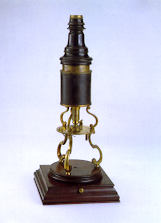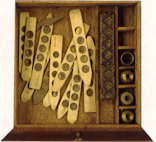
41 x 17.5 x 15.5
Wood, bronze, ivory and glass

INDEX 1788 : V.IV.357
Microscopium ex tribus lentibus compositum, pedamento aeneo insistens cum subjacente speculo: Variae partes metalicae, et lentes quatuor objectivae variae magnitudinis, lamellae sex eburneae &c. Quae omnia in capsula servantur sub eodem Microscopio reposita.
A compound microscope with three lenses, held on a bronze shaft with a mirror at the bottom: several metal parts and four objectives of different sizes, six ivory slides etc. All these items are kept in a box under the microscope itself.
Peter van Musschenbroek, in his Introductio ad Philosophiam Naturalem, states that when a single lens does not amplify an image sufficiently, then a second or even third should be added, as the Dutchman Drebbel did in 1621. He, according to Musschenbroek , was the inventor of the compound microscope.
When three lenses are used, as with this microscope, the image is darker. The object thus needs intense illumination for a good result, which is not necessary for a two-lens microscope. Proper lighting is achieved by using a concave mirror, preferably metal, which directs light on the object, from the sun or another source with sufficient intensity.
The instrument in the Museum has a funnel-shaped upper part joined to a cylindrical tube that fits into another which has three curved, bronze feet; the narrow tube is located between these feet and its lower end holds the objective; the microscope stage also rests on three curved, bronze feet, and a base with a drawer. The upper part is made of wood and consists of separate pieces which can be dismantled and which hold the ocular and the other lens, referred to above.
The distance between the eyepiece and the objective is fixed; the distance between the objective and the stage is regulated by raising or lowering the sleeve which fits in the cylindrical tube on the three feet, held in place by friction. The sleeve has five marks numbered 1 to 5 indicating its position, when raised, in relation to each of the five (not four, as the Index says) objectives of the microscope.
The reflecting mirror is missing, but it would have had a stem inserted in the centre of the wooden base containing the drawer. There is, at any rate, a hole suggesting that this was so.
The Index says that there were four object lenses of different magnifying power, six ivory slides (and various other pieces whose existence is indicated by &c, without saying what they were), which were kept in the drawer, and where they can still be found.
Although the Index mentions four objectives, in fact there were five. This is not just because there actually are five, numbered 1 to 5, but rather because there are five marks on the microscope to assist in focusing, as described above.
The six ivory slides mentioned in the Index are for microscopic preparations. Four of them hold 5 preparations; the other twohold 4 preparations. Each preparation is placed in a round hole in the slides and protected by mica discs. Only one preparation from one of the larger slides is missing.
Microscopic observation was not achieved by placing the slide on the stage, as it is today. In the middle of the stage, above its central opening, was a small metal bridge in the shape of an inverted U. Below this bridge there was a small spiral clip resting on the stage. The slide with the preparations was wedged between the top of this clip and the top of the bridge.
From Colégio dos Nobres, catalogue n.º 344.
Carvalho, Rómulo de, História do Gabinete de Física da Universidade de Coimbra, Universidade de Coimbra, Biblioteca Geral, Coimbra, 1978, pp 504-507.
Musschenbroek, Peter Van, Introductio ad Philosophiam Naturalem, Leiden, 1762, Tab. XLV, Fig. 5 and 6.